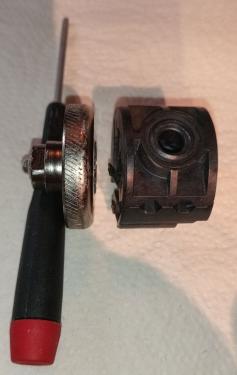05-31-2023, 03:30 PM
I shoved a wad of paper towel down into the tube and up against the back of the switch assembly. Got it good and wet with some white vinegar and let it sit for roughly 45 minutes. When I went to pull the paper towel out of the tube I noticed the top 1/3rd of the switch moved back slightly all on it's own. 
Then I was able to push that piece out through the back of the tube with a pocket screwdriver using the push-button hole in the top of the flashlight body for access. After that was out there was plenty of room to push the rest of the switch out too. The base of the LED module was still stuck tight in the tube though. Had to break out the heat gun and warm up the tube to get some expansion going, then used a piece of 1" schedule 40 PVC pipe and a dead blow hammer to finally drive it out of the tube. Once it was out I could see that the inside of the tube is knurled where the LED base presses into it. So it's not meant to be a slip-fit.
Also it turns out the "switch" assembly is stacked together using 3 housing pieces and a printed circuit board. The actual "switch" is just a metal snap dome wafer that makes contact with pads on the opposite side of the PCB. I got all the pieces cleaned up and put back together and it lives again. That's $60 I didn't have to spend again to replace it!



Then I was able to push that piece out through the back of the tube with a pocket screwdriver using the push-button hole in the top of the flashlight body for access. After that was out there was plenty of room to push the rest of the switch out too. The base of the LED module was still stuck tight in the tube though. Had to break out the heat gun and warm up the tube to get some expansion going, then used a piece of 1" schedule 40 PVC pipe and a dead blow hammer to finally drive it out of the tube. Once it was out I could see that the inside of the tube is knurled where the LED base presses into it. So it's not meant to be a slip-fit.

Also it turns out the "switch" assembly is stacked together using 3 housing pieces and a printed circuit board. The actual "switch" is just a metal snap dome wafer that makes contact with pads on the opposite side of the PCB. I got all the pieces cleaned up and put back together and it lives again. That's $60 I didn't have to spend again to replace it!

Willie




